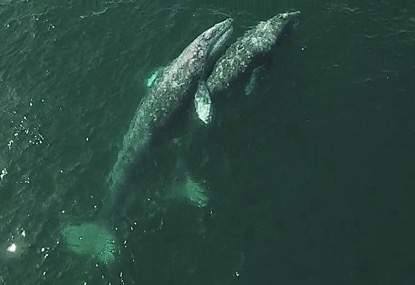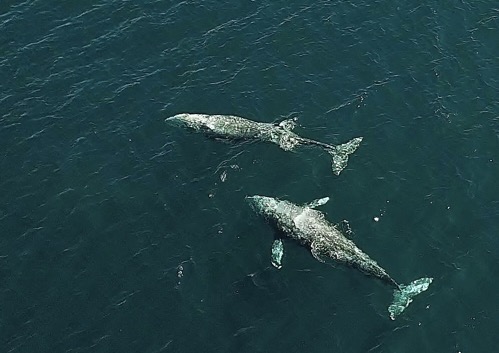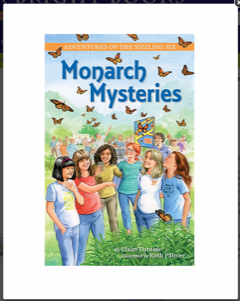YA Eco Mysteries, Memoirs, Novels & Travel
09 January 2022
Eco Fiction Writer's Blog Episode 3
13/01/22 09:51 Filed in: Environmental Fiction
Episode 3. My Writing Journey Continues: Whalefall

Gray Whale Mother and Calf off the Coast of California (Gavriel Berghouse)
Like uncorking a bottle of champagne, ideas pop and fizz in my head. I snare a few to weave into the story
Here are the latest titles that I’m considering for Book 2 of the Climate Change Trilogy: Fire, Water, and Air.
1. “The Time Has Come,” The Whale Said (Book 2 Water)
2. The Whale’s Lament (Book 2 Water)
3) Three Amigos and a Magnificent Whale (Book 2 Water)
4)Whalefall (Book 2 Water)
Please let me know which title you prefer? Email me at: cldatnow@me
Note: Red Flag Warning: An Eco Adventure (BooK1. Fire) is the first published book in the Climate Change Trilogy.
In preparation for Chapter 3, I researched the scientific facts governing the phenomenon of a whalefall.
Summary of Chapter 3: Alysie Muckpa, the teenage protagonist of the story, hears the gray whale Natislane calling to her, “The time has come!”
She begs the whale not to come closer to the shore, but he washes up on the beach. Without water to keep him afloat, the weight of Natsilane’s gigantic body begins to crush his internal organs. Alysie is heartbroken at the death of her whale. But she learns that as smelly as 100 tons of decomposing flesh can be, a dead whale is a scientific goldmine for her cousin Valentine’s marine research team. His carcass provides an opportunity for them to perform a necropsy, to reveal the cause of the whales death, and to understand a creature that is frequently beyond their reach.

Gray Whales, California (Gabby Berghouse)
In Preparation for Chapter 3, I Researched the Science Behind What Happens When a Whale Dies at Sea.
Soon after the death, the whale’s inside organs begin to decompose, releasing gases and causing it to float up to the surface where it is scavenged by sharks and seabirds.
Eventually, the ocean giant will begin to sink, falling slowly, until finally coming to rest on the seabed. This phenomenon is know as a whalefall. The giant takes decades to sink to the ocean floor.
As it falls whales provide food for whole ecosystem of deep-sea creatures, from large scavengers to microscopic bacteria. Sea snails, bristle worms and shrimp devour any remaining scraps of blubber or muscle. The worms, such as Osedax mucofloris—a name which literally means 'bone-eating snot-flower'—bore their bacteria-filled roots into the whale’s bone, leaving their feathery plumes waving in the open water to take in oxygen.
In death the whales provide life for hundreds of marine animals for up to 50 years, proof of the vital role they play in the life cycle within Earth's oceans.
I Decide to Weave this Complex Process into a Poem
Chapter 3. Whalefall
A blinding, neon fork of lightning struck the tall pine close to the boulder Alysie had been standing on, momentarily blinding her with intense light. Alysie’s head fell back against the whale. Half dreaming, half conscious images flashed behind her eyelids. She felt as if she were tumbling down into an endless underwater canyon . . .
Down. Down. Down beneath the slow black, crow black sea
Deeper than sleep,
Dimmer than night!
Down. Down. Down beneath the slow black, crow black sea
Her eyes grow accustomed to the dark where
Seahorses, jellyfish and octopuses pulse beside her.
Down. Down. Down through silent, swaying forests of
Kelp and brown seaweed—Laminaria, Alaria, and Nereocystis,
Red seaweed—Porphyra and Palmaria.
“Will this fall never end?” the whale gurgled.
“Go to sleep, close your eyes, Natsilane,” Alysie crooned.
Down. Down. Down to where
Biting, ripping hag fish, sharks, and whales
Feast on Natsilane,
Gorge on his thick, rich blubber.
Down. Down. Down to where
Worms, barnacles, crabs, and mussels
Burrow into leftover muscle and bone.
Down. Down. Down into the sea of Alysie’s dreams where
Past, present, and future,
Flow, curve, and merge.
Down. Down. Down to where
Natsilane comes to rest on the bottom of the seabed
In the briny darkness where
The skulls of the long-drowned lie where
Tiny deep-sea scavengers—
Luminous worms, sea snails, and shrimps
Feed and breed on Natsilane’s skeleton
Down. Down. Down into deepest canyon where
Microbes mingle, consuming the whale’s cells
Swimming in methane gas bubbling from thermal vents,
And know nothing of the great grey whale.
Natislane, Oh, Natsilane . . .
Does this successfully weave scientific information in a poetic form? Email me at: cldatnow@me.com
Subscribe to my newsletter at: mediamint.net to read new episodes of “A Writer’s Journey.”
Coming Soon: Episode 4 “From Death Comes Life,” will reveal How a Whalefall is Connect to Climate Change.

Gray Whale Mother and Calf off the Coast of California (Gavriel Berghouse)
Like uncorking a bottle of champagne, ideas pop and fizz in my head. I snare a few to weave into the story
Here are the latest titles that I’m considering for Book 2 of the Climate Change Trilogy: Fire, Water, and Air.
1. “The Time Has Come,” The Whale Said (Book 2 Water)
2. The Whale’s Lament (Book 2 Water)
3) Three Amigos and a Magnificent Whale (Book 2 Water)
4)Whalefall (Book 2 Water)
Please let me know which title you prefer? Email me at: cldatnow@me
Note: Red Flag Warning: An Eco Adventure (BooK1. Fire) is the first published book in the Climate Change Trilogy.
In preparation for Chapter 3, I researched the scientific facts governing the phenomenon of a whalefall.
Summary of Chapter 3: Alysie Muckpa, the teenage protagonist of the story, hears the gray whale Natislane calling to her, “The time has come!”
She begs the whale not to come closer to the shore, but he washes up on the beach. Without water to keep him afloat, the weight of Natsilane’s gigantic body begins to crush his internal organs. Alysie is heartbroken at the death of her whale. But she learns that as smelly as 100 tons of decomposing flesh can be, a dead whale is a scientific goldmine for her cousin Valentine’s marine research team. His carcass provides an opportunity for them to perform a necropsy, to reveal the cause of the whales death, and to understand a creature that is frequently beyond their reach.

Gray Whales, California (Gabby Berghouse)
In Preparation for Chapter 3, I Researched the Science Behind What Happens When a Whale Dies at Sea.
Soon after the death, the whale’s inside organs begin to decompose, releasing gases and causing it to float up to the surface where it is scavenged by sharks and seabirds.
Eventually, the ocean giant will begin to sink, falling slowly, until finally coming to rest on the seabed. This phenomenon is know as a whalefall. The giant takes decades to sink to the ocean floor.
As it falls whales provide food for whole ecosystem of deep-sea creatures, from large scavengers to microscopic bacteria. Sea snails, bristle worms and shrimp devour any remaining scraps of blubber or muscle. The worms, such as Osedax mucofloris—a name which literally means 'bone-eating snot-flower'—bore their bacteria-filled roots into the whale’s bone, leaving their feathery plumes waving in the open water to take in oxygen.
In death the whales provide life for hundreds of marine animals for up to 50 years, proof of the vital role they play in the life cycle within Earth's oceans.
I Decide to Weave this Complex Process into a Poem
Chapter 3. Whalefall
A blinding, neon fork of lightning struck the tall pine close to the boulder Alysie had been standing on, momentarily blinding her with intense light. Alysie’s head fell back against the whale. Half dreaming, half conscious images flashed behind her eyelids. She felt as if she were tumbling down into an endless underwater canyon . . .
Down. Down. Down beneath the slow black, crow black sea
Deeper than sleep,
Dimmer than night!
Down. Down. Down beneath the slow black, crow black sea
Her eyes grow accustomed to the dark where
Seahorses, jellyfish and octopuses pulse beside her.
Down. Down. Down through silent, swaying forests of
Kelp and brown seaweed—Laminaria, Alaria, and Nereocystis,
Red seaweed—Porphyra and Palmaria.
“Will this fall never end?” the whale gurgled.
“Go to sleep, close your eyes, Natsilane,” Alysie crooned.
Down. Down. Down to where
Biting, ripping hag fish, sharks, and whales
Feast on Natsilane,
Gorge on his thick, rich blubber.
Down. Down. Down to where
Worms, barnacles, crabs, and mussels
Burrow into leftover muscle and bone.
Down. Down. Down into the sea of Alysie’s dreams where
Past, present, and future,
Flow, curve, and merge.
Down. Down. Down to where
Natsilane comes to rest on the bottom of the seabed
In the briny darkness where
The skulls of the long-drowned lie where
Tiny deep-sea scavengers—
Luminous worms, sea snails, and shrimps
Feed and breed on Natsilane’s skeleton
Down. Down. Down into deepest canyon where
Microbes mingle, consuming the whale’s cells
Swimming in methane gas bubbling from thermal vents,
And know nothing of the great grey whale.
Natislane, Oh, Natsilane . . .
Does this successfully weave scientific information in a poetic form? Email me at: cldatnow@me.com
Subscribe to my newsletter at: mediamint.net to read new episodes of “A Writer’s Journey.”
Coming Soon: Episode 4 “From Death Comes Life,” will reveal How a Whalefall is Connect to Climate Change.



